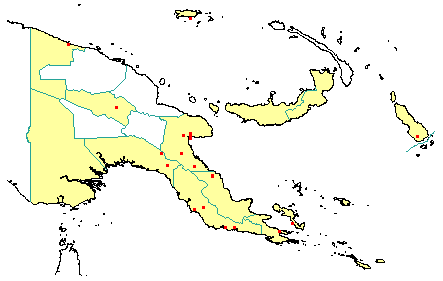
in PNGplants database
PNGTreesKey – Trichadenia philippinensis Merr. |
Barry Conn (NSW) & Kipiro Damas (LAE).
Guide to trees of Papua New Guinea
Copyright held by the authors, National Herbarium of New South Wales, and Papua New Guinea National Herbarium
Philippine Journal of Science Vol. 4: 298 (Bot.) (1909)
Other Literature: H. Sleumer, Flora Malesiana, Series 1, 39-40 (1954)
Family: Salicaceae
Dicotyledon
Timber Group: Occasional timber species
Field Characters: Large canopy tree (rarely usually 25-33 m high) or Small sub-canopy tree; Bole cylindrical (up to c. 100 cm diam.); straight (bole up to c. 20 m long); buttresses buttresses present (usually buttresses up to c. 2 m high) or buttresses absent; spines spines absent; aerial roots aerial roots absent; stilt roots stilt roots absent; Bark white, grey, or yellowish brown, rough, fissured; Subrhytidome (under-bark) white, pale yellow, or pale orange; less than 25 mm thick, 12.0-20.0; bark blaze consisting of one layer; faintly to non-aromatic; outer blaze white or yellow (pale (cream- to straw-coloured), markings absent; inner blaze white or yellow (pale (cream- to straw-coloured), markings absent; bark exudate (sap) absent; terminal buds not enclosed by leaves.
Indumentum: Complex hairs absent; stinging hairs absent; mature twig indumentum (hairs) absent.
Leaves: Leaves clustered at end of branches (in pseudowhorls), spiral (leaves occurring singly at a node and arranged spirally up the branchlet), simple (a leaf composed of a single blade); petiole present (short), not winged, attached to base of leaf blade, not swollen; leaves broadest at or near middle, 14.0-30.0 cm, 60.0-150.0 (-200.0) cm; symmetric, entire, not dissected or lobed, abruptly acuminate, venation pinnate, secondary veins open, prominent, intramarginal veins absent; leaves lower surface dull pale green or brown (pale (hairs reddish brown), upper surface dark green, indumentum (hairs) absent (above) or present (below), indumentum (hairs) dense; absent; domatia absent; stipules present, free, laterally placed, not encircling the twig, leafy, not fringed, large, not persistent.
Flowers: Inflorescence axillary, flowers on an unbranched axis or flowers on a branched axis, cones absent; flowers unisexual, unisexual with male and female flowers on different plants, stalked, flowers with many planes of symmetry, 3.0-4.0 mm long, diameter small (up to10 mm diam.); perianth present, with distinct sepals and petals whorls, inner perianth greenish yellow or orange (pale (slightly golden-coloured); 5, free; stamens 5 (in male flowers), present, free of each other, free of the perianth; ovary superior, carpels joined (when more than one), locules 3; styles free, 3.
Fruits: Infrutescence arranged on unbranched axis or arranged on branched axis, fruit 20.0-40.0 mm long, orange, brown, or grey, not spiny, fleshy, simple, indehiscent, berry; seeds 3, about 10 mm long (10-15 mm long), not winged, broad (as wide as long), seed more than 10 mm diam. (10-15 mm diam.).
Distribution: West Sepik, Morobe, Western Highlands, Western, Gulf, Central, Northern, Milne Bay, Papuan Islands, New Britain, Manus & Bougainville.
 | Botanical records in PNGplants database |
Notes: Notes The taxonomic position of this genus is not known, but since it was previously classified in the family Flacourtiaceae, it is here transferred to the family Salicaceae.